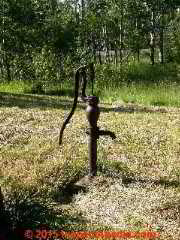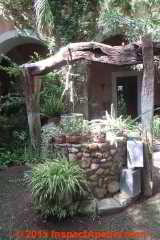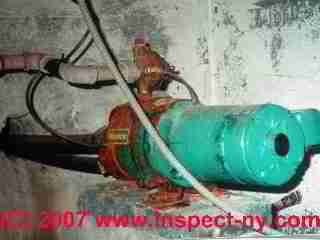 Well Pump Life Expectancy
Well Pump Life Expectancy
Life of Jet Pumps, Submersible Pumps, Hand Pumps, Solar Pumps, VFD Pumps, Wind Operated Pumps
- POST a QUESTION or COMMENT about things that impact the life of a well pump or water pump
Well pump & water pump life:
This article series describes the different types of water pumps or well pumps, and we list the factors affecting the life expectancy of water pumps and we include a list of steps to take to maximize the life of a well or water pump and its motor.
InspectAPedia tolerates no conflicts of interest. We have no relationship with advertisers, products, or services discussed at this website.
- Daniel Friedman, Publisher/Editor/Author - See WHO ARE WE?
Life Expectancy of Water Pumps - varies by pump type, usage, and other factors
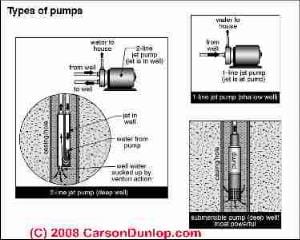 In this article we discuss how long you can expect a water pump to last and what factors affect its life.
In this article we discuss how long you can expect a water pump to last and what factors affect its life.
Specifics of different types of water pumps can be read in detail at these articles:
How Long Does a Water Pump Last?
Well pump life depends - on pump type, duty cycle, usage, water chemistry, even voltage levels.
Above, our sketch of a types of well water pumps is courtesy of Carson Dunlop Associates. The drawing shows the key differences between a one line jet pump, two line jet pump, and a submersible water pump.
Jet Pump Life Expectancy
An above-ground one line (shallow well) or two line (deep well) jet pump often operates for a considerable range of years, as few as 4 years or as many as 15 or 20 years before needing replacement.
A typical well pump life expectancy (lumping both the electric pump motor and the pump assembly together) is about 10 years in the U.S. and Canada, and about 5 years in Mexico and Central America.
See details about jet pumps at
and
Submersible Water Pump Life Expectancy
A submersible well pump, perhaps because the motor is kept cool by being immersed in well water, can also have a considerable range of life expectancies depending on the variables which we list below.
A submersible pump operating in low-sediment water may have a 15 year life while the same pump in high sedimented water and without adequate sediment and check valve protection may fail in 5 or 6 years.
See details at WATER PUMP, SUBMERSIBLE
Hand dug well Pitcher Pump Life Expectancy
Below we illustrate a traditional cast-iron hand pump on a drilled well in Two Harbors, Minnesota.
Photo above, courtesy Lon Church, Summerblue Arts Camp, Two Harbors, MN.
A pitcher pump or hand pump itself, has a design life of 15-20 years but with a little maintenance such as lubrication, can last decades.
The leathers that produce the water lift ability on hand pumps or pitcher pumps on shallow wells need to be replaced every 3-5 years.
Hand-operated well pumps or pitcher pumps may last for 50 years or more, thanks to their mechanical simplicity and provided that the well itself is constructed for long life.
However replacement of the hand pump's working parts, particularly the pump leathers, will be required as often as every 5-10 years depending on the pump's use, climate, and maintenance.
See details at HAND PUMP for WELLS
HAND DUG WELLS includes sources for hand pumps or pitcher pumps and repair parts.
Rope & Bucket, Hand Dug Well Life
Below: in the simplest of wells, the rope and bucket and winch system of this 1700's dug well is still in operation at Las Trancas in Guanajuato, Mexico.
The life expectancy of these simple hand dug wells depends on the climate and changes in the water table rather than on the equipment used to lift water from the well.
Factors Affecting the Expected Life of a Well Water Pump
- Water Pump duty cycle: a water pump which is called-on to run just a few times a day will have a considerably longer life than the same pump under heavy or continuous use.
One of the reasons that owners install a larger or captive-air bladder-type water pressure tank is to extend the water draw-down cycle and thus reduce the frequency of turning the water pump on and off. For details
see WATER PUMP DUTY CYCLE - Water Pump electric motor horsepower or motor size: for the same application and workload, a larger electrical motor, for example a 3/4 or 1 HP (horsepower, or CP, caballo podre in Latin America) motor will usually outlast a small fractional 1/8 or 1/4 hp electrical motor.
- Water pump motor quality will affect how long the pump's electric motor (or any electric motor) will last. Variables include the type and quality of electric motor bearings and its lubrication requirements.
Where an electric motor is manufactured, even when it claims to be the same brand, can make a significant difference.
For example according to our Mexican consultants, electric pump motors made in Mexico sometimes perform less durably than a similar motor manufactured to U.S. standards. - Water sediment is a major wear factor on the pump assembly itself (as opposed to the electric motor that drives the pump). Sediment in water acts as an abrasive that wears pump bearings and other moving parts.
- Quality of Water Equipment Installation: can make a big difference in the life of the water supply equipment. Installers who simply hook up a pump and wiring, with no understanding of the importance of proper location of check valves, filters, proper electrical wiring, etc. are likely to be providing a shorter-lived water supply system.
- Proper match of the well pump capacity and its output rate to the well's safe yield.
See WELL YIELD DEFINITION where we define safe well yield.
Also
see AIR DISCHARGE at FAUCETS, FIXTURES.
Which Parts Wear Out on Water Pumps?
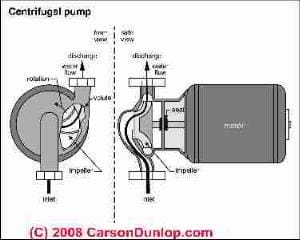
Water pumps operated by an electric motor
What looks like "a well pump or water pump" actually is a collection of major assemblies and more numerous minor parts.
The major assemblies on an above ground water pump (such as a one line or two line jet pump) include the electric motor that drives the pump and the actual pumping assembly that moves water from the well to the water pressure tank and on into the building.
You an see the pump impeller in the sketch at left. Hard water, dirt and sediment, little stones, or other debris can damage this component: the pump motor may run just fine but less water pressure or flow may be delivered by the pump.
A submersible pump includes these two major assemblies (electric pump motor and water pump assembly) and adds an internal check valve.
Sketch courtesy of Carson Dunlop Associates, a Toronto home inspection, education & report writing tool company [ carsondunlop.com ].
- Pump bearings
- Pump impeller or rotary vanes that move water - see sketch above
- Pump motor bearings inside the electric motor that drives the water pump
- Internal pump check valves
- Pump control switches which are normally physically separate devices, also wear or fail, becoming clogged with sediment or suffering burned electrical contacts.
See WELL PUMP PRESSURE CONTROL ADJUSTMENT for details. - Other well piping components that are not part of the well pump itself, but that affect pump life, such
as WELL PIPING CHECK VALVES, WELL PIPING FOOT VALVES,
or
a WELL PIPING TAIL PIECE may also need to be installed, repaired, or replaced.
Also see WATER PUMP LIFE MAXIMIZATION for a list of steps to take to get the most life out of a well pump or water pump.
What is Well Pump Cavitation?
Well pump cavitation describes the entry of air or gases into the mechanical parts that are trying to move water through a water pump.
The presence of air or other gases in the actual pump chambers or around the water pump impellers leads to overheating of these parts and mechanical damage to the pump moving parts.
Cavitation can also cause the pump to have to work longer to satisfy the water demand and thus its electric motor to overheat, also reducing motor life.
Cavitation inside of a water pump can be caused by several problems including:
- Inadequate well yield: if the yield of a well drops for any reason, trying to pump water beyond the safe yield of a well pump can introduce air into the well pump and water piping.
See WELL YIELD DEFINITION where we define safe well yield.
Also see AIR DISCHARGE at FAUCETS, FIXTURES. - Oversized pumps that mismatch the well flow rate to the pump's output rate can also cause the pump to form a strong vacuum inside the pumping chamber around the pump impeller. The vacuum, in turn, causes dissolved gases in the water itself to leave solution and return to bubble form.
Low Water Cutoff Devices and Well Tailpieces for Well Pump Protection on a Low-Flow-Rate Well
 For details about well pipe tailpieces, tail pipes, or other low water cutoff devices that protect the well pump from damage when the well flow is too limited, please see our compete article at WELL PIPING TAIL PIECE. Excerpts are just below.
For details about well pipe tailpieces, tail pipes, or other low water cutoff devices that protect the well pump from damage when the well flow is too limited, please see our compete article at WELL PIPING TAIL PIECE. Excerpts are just below.
When the well pump's capacity is known to exceed the flow rate of the well, a tail pipe, tail piece, or low water cutoff control is installed to protect the pump from damage.
The well piping tailpiece (also shown in this sketch [image file]) permits the in-well water pump to continue to run by recirculating well water within the pump but by halting delivery of water or slowing delivery of water to the building.
Many sources, including the Penn State School of Forest Resources recommend installing a low water cutoff device to protect a well pump that has to operate in an inadequate or low-yield well.
A still different approach that may provide some water pump protection by reducing the well pump cycling rate is the installation of a Smart Tank that regulates water flow in the building.
Pressure Sensitive Water Pumps & Inline Control Water Pumps
Pressure sensitive pumps and inline pump controllers provide water pressure boosting, rainwater harvesting, or similar functions without requiring a water pressure tank.
See WATER PUMP VARIABLE FREQUENCY / VARIABLE SPEED DRIVE (VFDs)
Research on Life Expectancy of Various Types of Water Well Pumps
- Gordon, Peter M., Matt C. Johnson, and Dylan A. Smith. DEEP WELL PUMP SEAL [PDF] (2017). [Class assignment] Mechanical Engineering Department,
California Polytechnic State University, San Luis Obispo
Abstract:
Lifewater International, a Christian non-profit, trains locals to repair water well hand pumps in various third world countries. It would be beneficial to retrofit difficult-to-repair hand pumps with a locally-made pump cylinder such as HydroMission's "SlapShot".
The majority of the components in the "SlapShot" can be easily obtained in rural third world villages.
However, the thick leather gaskets required to seal the water cylinder during the pumping operation are imported. These thick leather gaskets are expensive, and when they fail, this results in pumps being out of commission for extended periods of time.
Lifewater has presented this problem to a team of three undergraduate mechanical engineering students at California Polytechnic State University, San Luis Obispo with the goal of being able to locally source and manufacture an adequate seal to replace the current thick leather seal.
Excerpts:
The life cycle and leak rates cannot be determined without testing, so these … pump seals. The users would continue using the pump until absolutely no water was coming out, making life … - Iskenderli, I. N., I. S. Kuliev, V. A. Narimanov, and F. M. Kel’biev. "Analysis of efficiency of methods for improving sucker-rod deep-well pump plungers and choice of an alternative method." Chemical and Petroleum Engineering 49, no. 7 (2013): 536-538.
- McCarter, A. B., S. V. Os Jr, and R. E. Blount. Well pump for fluids and vapors. No. US 3884299. 1975.
- Muth, G. M., and T. M. Walker. "Extending Downhole Pump Life Using New Technology." In SPE Western Regional Meeting. OnePetro, 2001.
- Ondrey, Gerald. "Analyzing pump life-cycle costs." Chemical Engineering 107, no. 12 (2000): 33.
- Truslove, Jonathan P., Andrea B. Coulson, Emma Mbalame, and Robert M. Kalin. "Barriers to handpump serviceability in Malawi: Life-cycle costing for sustainable service delivery." Environmental Science: Water Research & Technology 6, no. 8 (2020): 2138-2152.
Includes a discussion of the life expectancy of hand pumps or pitcher pumps on water wells.
Abstract excerpt:
The implementation of handpumps has contributed to increased improved water access. However,'universal access' as the metric for success within Sustainable Development Goal (SDG) 6, potentially conceals fundamental barriers for sustainable services and hinders SDG 6 target success.
Tariffs, in the form of household contributions, are the most common form of financial provision for the maintenance of rural water supplies. ... The findings highlight the burden placed on rural communities of maintaining inherently unsustainable assets that inevitably hinders lasting service delivery and benefits for rural communities in the SDG period and beyond. - Walski, Thomas, Kyle Zimmerman, Mark Dudinyak, and Preethy Dileepkumar. "Some surprises in estimating the efficiency of variable-speed pumps with the pump affinity laws." In World Water & Environmental Resources Congress 2003, pp. 1-10. 2003.
- Ylaya, Vrian Jay V., and Ruel T. Buba. PERFORMANCE ANALYSIS OF SOLAR POWERED WATER WELL PUMP [PDF]” International Research Journal of
Advanced Engineering and Science, Volume 7, Issue 2, pp. 85-89, 2022.
Abstract
The Philippines is abundant in water. In remote areas, sources of water are from wells. The collection of water needs effort and is laborious. Mechanical pumps are available to collect water from the well automatically, but this is impossible in remote areas deprived of electricity.
This research addresses the later issue: water pumps are powered with solar. The performance of the solar-powered water well pump is analyzed from their series and parallel connections based on the provided flow rate—data analysis using a two-tailed ttest implemented in Python.
The Ho is that there is no significant difference in the flow rate of series and parallel connections of the solar-powered water well pump. The p-value solve is 1.346, which rejects the null hypothesis. Thus, there is a significant difference in the performance of series and parallel connections of the solar-powered water well pump.
Efficiently, a parallel connection performed well in implementing a solar-powered water well pump. - Access Water Energy, PO Box 2061, Moorabbin, VIC 3189, Australia, Tel: 1300 797 758, email: sales@accesswater.com.au Website: http://www.accesswater.com.au/
Moorabbin Office: Kingston Trade Centre, 100 Cochranes Rd, Moorabbin, VIC 3189
Australian supplier of: Greywater systems, Solar power to grid packages, Edwards solar systems, Vulcan compact solar systems, water & solar system pumps & controls, and a wide rage of above ground & under ground water storage tanks: concrete, steel, plastic, modular, and bladder storage tanks. - Flexcon, SMART TANK INSTALLATION INSTRUCTIONS [PDF], Flexcon Industries, 300 Pond St., Randolph MA 02368, www.flexconind.com, Tel: 800-527-0030 - web search 07/24/2010, original source: http://www.flexconind.com/pdf/st_install.pdf
- Grove Electric, Typical Shallow Well One Line Jet Pump Installation [PDF], Grove Electric, G&G Electric & Plumbing, 1900 NE 78th St., Suite 101, Vancouver WA 98665 www.grovelectric.com - web search -7/15/2010 original source: http://www.groverelectric.com/howto/38_Typical%20Jet%20Pump%20Installation.pdf
- Grove Electric, Typical Deep Well Two Line Jet Pump Installation [PDF], Grove Electric, G&G Electric & Plumbing, 1900 NE 78th St., Suite 101, Vancouver WA 98665 www.grovelectric.com - web search -7/15/2010 original source: http://www.groverelectric.com/howto/38_Typical%20Jet%20Pump%20Installation.pdf
- See additional citations at the page bottomReferences or Citations
...
Reader Comments, Questions & Answers About The Article Above
Below you will find questions and answers previously posted on this page at its page bottom reader comment box.
Reader Q&A - also see RECOMMENDED ARTICLES & FAQs
Question: does pressure control switch setting level affect well pump life?
2019/03/31 Gary said:
Are low (20/40) or high (40/60) switch settings better or worse for pump life, and why?
This Q&A were posted originally
at WATER PUMP DRAWDOWN VOLUME & TIME
Reply:
Gary
I offer two apparently but not really contradictory answers:
1. A pump that is required to reach a higher cut-off pressure before it turns off - all else being equal - has to work a bit harder so might run a bit longer or a bit hotter, factors that *could* affect pump life.
2. However, As long as you are operating a water pump within the pressure range for which it is designed and more-important the duty cycle for which it's designed, the cut-off pressure range should not measurably affect the pump life.
Starting at WATER PUMP LIFE EXPECTANCY (at the top of this very page) you'll see that there are factors that affect well pump life, among which the pressure control switch does, indirectly play a part.
In my opinion the most harmful problems affecting pump life are rapid on-off short-cycling. (see SHORT CYCLING at the end of this page)
...
Continue reading at WATER PUMP LIFE MAXIMIZATION or select a topic from the closely-related articles below, or see the complete ARTICLE INDEX.
Or see WATER PUMP LIFE EXPECTANCY FAQs - questions and answers posted originally at the end of this article.
Or see these
Recommended Articles
- WATER PUMP CAPACITIES TYPES RATES GPM - general pump capacities and operating ranges
- WATER PUMP DUTY CYCLE
- WATER PUMP LIFE EXPECTANCY
- WATER PUMP LIFE MAXIMIZATION - how to get the longest life out of your well pump
- WATER PUMP VARIABLE FREQUENCY / VARIABLE SPEED DRIVE (VFDs)
- WATER PUMP SHORT CYCLING
- WATER PUMP WONT STOP RUNNING - abnormally long water pump running times or running the pump motor dry
- WATER TANK LIFE EXPECTANCY
- WELL LIFE EXPECTANCY
Suggested citation for this web page
WATER PUMP LIFE EXPECTANCY at InspectApedia.com - online encyclopedia of building & environmental inspection, testing, diagnosis, repair, & problem prevention advice.
Or see this
INDEX to RELATED ARTICLES: ARTICLE INDEX to WATER SUPPLY, PUMPS TANKS WELLS
Or use the SEARCH BOX found below to Ask a Question or Search InspectApedia
Ask a Question or Search InspectApedia
Questions & answers or comments about things that impact the life of a well pump or water pump.
Try the search box just below, or if you prefer, post a question or comment in the Comments box below and we will respond promptly.
Search the InspectApedia website
Note: appearance of your Comment below may be delayed: if your comment contains an image, photograph, web link, or text that looks to the software as if it might be a web link, your posting will appear after it has been approved by a moderator. Apologies for the delay.
Only one image can be added per comment but you can post as many comments, and therefore images, as you like.
You will not receive a notification when a response to your question has been posted.
Please bookmark this page to make it easy for you to check back for our response.
IF above you see "Comment Form is loading comments..." then COMMENT BOX - countable.ca / bawkbox.com IS NOT WORKING.
In any case you are welcome to send an email directly to us at InspectApedia.com at editor@inspectApedia.com
We'll reply to you directly. Please help us help you by noting, in your email, the URL of the InspectApedia page where you wanted to comment.
Citations & References
In addition to any citations in the article above, a full list is available on request.
- Air in Drinking Water, Environmental Fact Sheet, New Hampshire Department of Environmental Services, 29 Hazen Drive, Concord NH 03301 - web search 07/14/2010 original source: http://des.nh.gov/organization/commissioner/pip/factsheets
/dwgb/documents/dwgb-3-18.pdf - Mark Cramer Inspection Services Mark Cramer, Tampa Florida, Mr. Cramer is a past president of ASHI, the American Society of Home Inspectors and is a Florida home inspector and home inspection educator. Mr. Cramer serves on the ASHI Home Inspection Standards. Contact Mark Cramer at: 727-595-4211 mark@BestTampaInspector.com
- John Cranor [Website: /www.house-whisperer.com ] is an ASHI member and a home inspector (The House Whisperer) is located in Glen Allen, VA 23060. He is also a contributor to InspectApedia.com in several technical areas such as plumbing and appliances (dryer vents). Contact Mr. Cranor at 804-873-8534 or by Email: johncranor@verizon.net
- Kinetic water rams are described and demonstrated at waterram.com/faq.php
- Penn State, Water Fact Sheet #3, USING LOW-YIELD WELLS [PDF], Penn State College of Agricultural Sciences, Cooperative Extension, School of Forest Resources, web search 07/24/2010, original source: http://pubs.cas.psu.edu/FreePubs/pdfs/XH0002.pdf
- Flexcon, SMART TANK INSTALLATION INSTRUCTIONS [PDF], Flexcon Industries, 300 Pond St., Randolph MA 02368, www.flexconind.com, Tel: 800-527-0030 - web search 07/24/2010, original source: http://www.flexconind.com/pdf/st_install.pdf
- Grove Electric, Typical Shallow Well One Line Jet Pump Installation [PDF], Grove Electric, G&G Electric & Plumbing, 1900 NE 78th St., Suite 101, Vancouver WA 98665 www.grovelectric.com - web search -7/15/2010 original source: http://www.groverelectric.com/howto/38_Typical%20Jet%20Pump%20Installation.pdf
- Grove Electric, Typical Deep Well Two Line Jet Pump Installation [PDF], Grove Electric, G&G Electric & Plumbing, 1900 NE 78th St., Suite 101, Vancouver WA 98665 www.grovelectric.com - web search -7/15/2010 original source: http://www.groverelectric.com/howto/38_Typical%20Jet%20Pump%20Installation.pdf
- Water Ace Jet Pump Installation Manual, instructions from Water Ace Pump Co., web search 08/28/2010, original source: http://www.waterace.com/pdf/R510%20R520%20and%20R100%20Jet%20Pumps%20Manual.pdf
Consumer hotline: 800-942-3343 - instructions for the installation and maintenance of
Water Ace shallow well pump Model R510 1/2 HP
Water Ace deep well pump Model R100 convertible 1HP and
Water Ace deep well jet pump Model R250 convertible 1/2 hp. - Our recommended books about building & mechanical systems design, inspection, problem diagnosis, and repair, and about indoor environment and IAQ testing, diagnosis, and cleanup are at the InspectAPedia Bookstore. Also see our Book Reviews - InspectAPedia.
- In addition to citations & references found in this article, see the research citations given at the end of the related articles found at our suggested
CONTINUE READING or RECOMMENDED ARTICLES.
- Carson, Dunlop & Associates Ltd., 120 Carlton Street Suite 407, Toronto ON M5A 4K2. Tel: (416) 964-9415 1-800-268-7070 Email: info@carsondunlop.com. Alan Carson is a past president of ASHI, the American Society of Home Inspectors.
Thanks to Alan Carson and Bob Dunlop, for permission for InspectAPedia to use text excerpts from The HOME REFERENCE BOOK - the Encyclopedia of Homes and to use illustrations from The ILLUSTRATED HOME .
Carson Dunlop Associates provides extensive home inspection education and report writing material. In gratitude we provide links to tsome Carson Dunlop Associates products and services.


